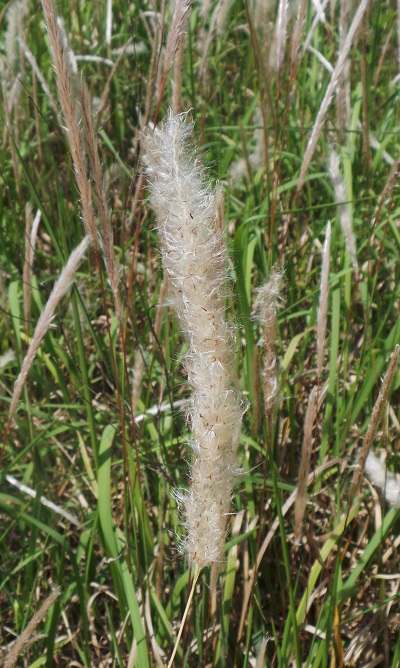
by Mark Mauldin | May 10, 2015
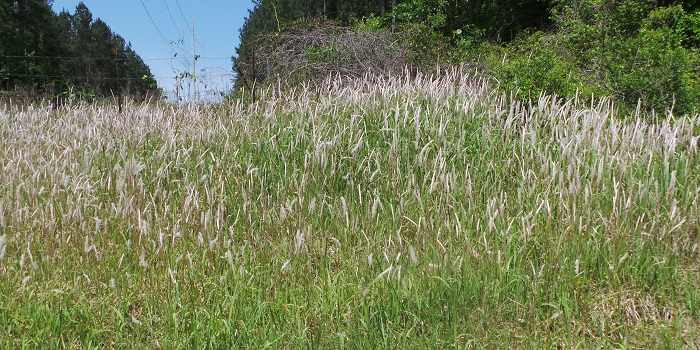
Cogongrass seedheads are easily spotted this time of year.
Photo Credit: Mark Mauldin
We are well into spring and a wide variety of plants are showing off their colorful blooms. As lovely as most of the blooms are, some springtime colors are an unwelcome sight. Such is the case with the showy, white seedhead that is produced by Cogongrass (Imperata cylindrica). The presence of Cogongrass – a highly aggressive, invasive, perennial – in Florida is not news; it has been in Florida since at least the 1930’s. However, the white seedhead that it produces in the spring makes it easier to locate and identify. When the seedhead is not present, the somewhat boring looking grass has the ability to blend in with its surroundings. This makes it harder for un-expecting landowners to identify the new/small infestations which are much easier to eliminate than are larger, well established infestations.

While cogongrass spreads primarily by rhizomes the seedheads can make new infestations easier to find.
Photo Credit: Mark Mauldin
Controlling cogongrass is not easy but it is necessary. If left uncontrolled cogongrass will continue to aggressively spread, displacing other desirable vegetation. Generally speaking, control is a multi-year process. Because the specific recommendations for controlling cogongrass can vary somewhat by situation it is highly advisable that you contact a UF/IFAS Extension Agent in your county if you suspect that you have cogongrass on your property.
The following description of cogongrass from UF/IFAS Center for Aquatic and Invasive Plants should help you identify cogongrass, even if the seedheads are gone.
“Cogongrass is a perennial that varies greatly in appearance. The leaves appear light green, with older leaves becoming orange-brown in color. In areas with killing frosts, the leaves will turn light brown during winter months and present a substantial fire hazard. Cogongrass grows in loose to compact bunches, each ‘bunch’ containing several leaves arising from a central area along a rhizome. The leaves originate directly from ground level and range from one to four feet in length. Each leaf is 1/2 to 3/4 of an inch wide with a prominent, off-center, white mid-rib. The leaf margins are finely serrated; contributing to the undesirable forage qualities of this grass. Seed production predominately occurs in the spring, with long, fluffy-white seedheads. Mowing, burning or fertilization can also induce sporadic seedhead formation. Seeds are extremely small and attached to a plume of long hairs.”
This is the time of year when cogongrass is the easiest to identify. Take advantage of this opportunity to locate new infestations and work with your county agent to develop a control plan. Once a plan is in place, follow it to the end. Stopping after the first year will practically ensure that control will not be achieved.
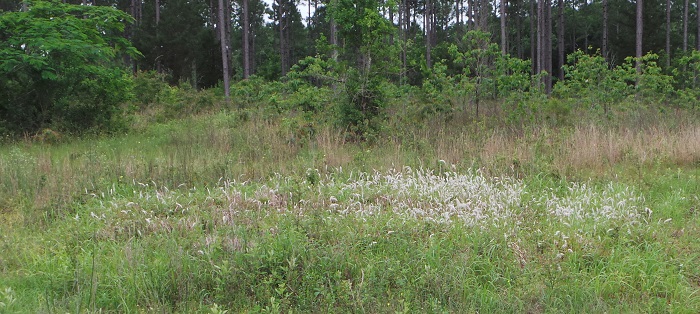
A relatively new patch of cogongrass recently found in Washington County.
Photo Credit: Mark Mauldin
More information on cogongrass can be found by following the links below
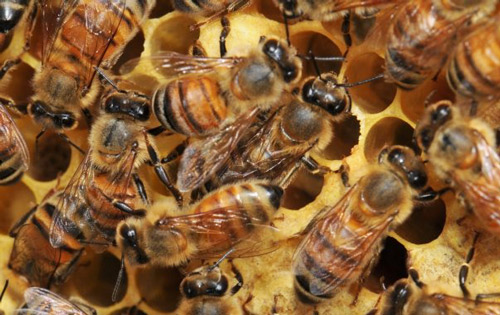
by Sheila Dunning | May 1, 2015
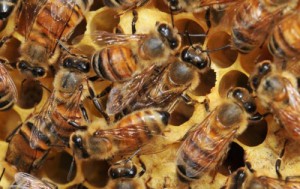
European Honey Bees
Photo: Ashley N. Mortensen; University of Florida
Bees have been disappearing at an alarming rate and continue to vanish without a trace. Why should anyone care? Well, they matter a lot more than most people think. Bees are the overwhelmingly dominant pollinator for most food crops. Native bees in the United States are responsible for pollinating over $15 billion worth of agricultural commodities annually. However, native bee populations are in decline due to habitat loss. At the same time, managed colonies of European honey bees have suffered a 50% decline over the past few decades. Numerous other pollinating insects are facing the same fate.
As the spring planting season is upon us, it’s exciting to think about all the wonderful produce we will have this summer. But, without pollinators many of these crops would not be available. The majority of fruit and vegetable food sources we eat are dependent on insect pollinators. One of every three bites of food Americans consume comes from a plant visited by bees or other pollinators.
As declining numbers of farmers work to meet the needs of an increasing population, they are forced to make choices on alternative to chemicals for pest control. “Good bug blends” of flowers can help attract pollinators as well as beneficial insects that suppress harmful pests. Establishment of these meadows can be done on a small or large scale and in any habitat. One approach to “bringing back the pollinators” is to intercrop with blooming plants that attract insects. Selecting a diversity of plants with different flower sizes, shapes and colors, as well as various plant heights and growth habits, will encourage the greatest numbers of pollinators. It is important to provide a continuous source of pollen and nectar throughout the growing season. At minimum, strive for three species to be blooming at any one time; the greater the diversity the better.
To enhance the garden, choose flowering plants that also provide shelter for beneficial insects. Many companion plants are suitable habitat for predators and parasitoids. Research in Florida has demonstrated that predatory minute pirate bugs can build to high numbers in sunflowers. The favorite food of minute pirate bugs is Western flower thrips. So, planting sunflowers on the perimeter of vegetable crops, such as peppers, can greatly reduce the damage caused by the thrips. Similar results were found with the planting of sorghum to attract beneficial mites and intercropping with buckwheat to house syrphid flies and parasitoid wasps. The garden vegetables experienced fewer spider mite, whitefly and aphid problems. Crimson clover, Hairy vetch and cosmos are other annual seed crops that can aid in attracting pollinators and harboring beneficial insects.
Insectary meadows can be created in the landscape and along roadways, not just in the garden. For more permanently planted areas, native wildflowers, grasses and woody plants serve as larval host plants for butterflies, and also provide nesting and overwintering sites for bumble bees, predacious beetles and other beneficial insects. Native perennial wildflowers such as blanketflower, tickseed, black-eyed Susan, partridge pea, narrowleaf sunflower, milkweed, beebalm, goldenrod and silkgrass can be installed in the spring as potted plants or seeded in the fall. Seeds require exposure to cold temperatures and damp conditions before germination can occur. In Florida, the best time is November to February.
Though grasses do not offer nectar or high-quality pollen, it is often useful to include at least one native bunch grass or sedge. Short, clump-forming grasses are preferable to large, spreading grasses. Hedgerow planting of woody species is a way to provide winter-blooming plants vital for supporting pollinators. Woody plants and grasses provide more than forage for pollinators, as many native bee species nest in the stems of plants or in the undisturbed ground underneath plantings. Suitable grasses include: beaked panicgrass, purple lovegrass, Muhly grass, broomsedge,little bluestem, wiregrass and toothache grass. Favored woody species that make good “beetle banks” include: fetterbush, American beautyberry, saw palmetto, Chickasaw plum, red maple, sparkleberry, Dahoon holly, redbud, blackgum, magnolia, buttonwood and sourwood.
Regardless of whether the objective is to establish herbaceous or woody vegetation, the time and effort spent on eradicating undesirable plants prior to planting will result in higher success rates in establishing the targeted plant community. Choose level, open sites that receive full sunlight and have limited weed populations. If perennial weeds are a problem, the use of herbicides that have no soil residual (e.g. glyphosate) may be necessary.
For more information on establishing planting for pollinators visit: www.xerces.org/pollinator.
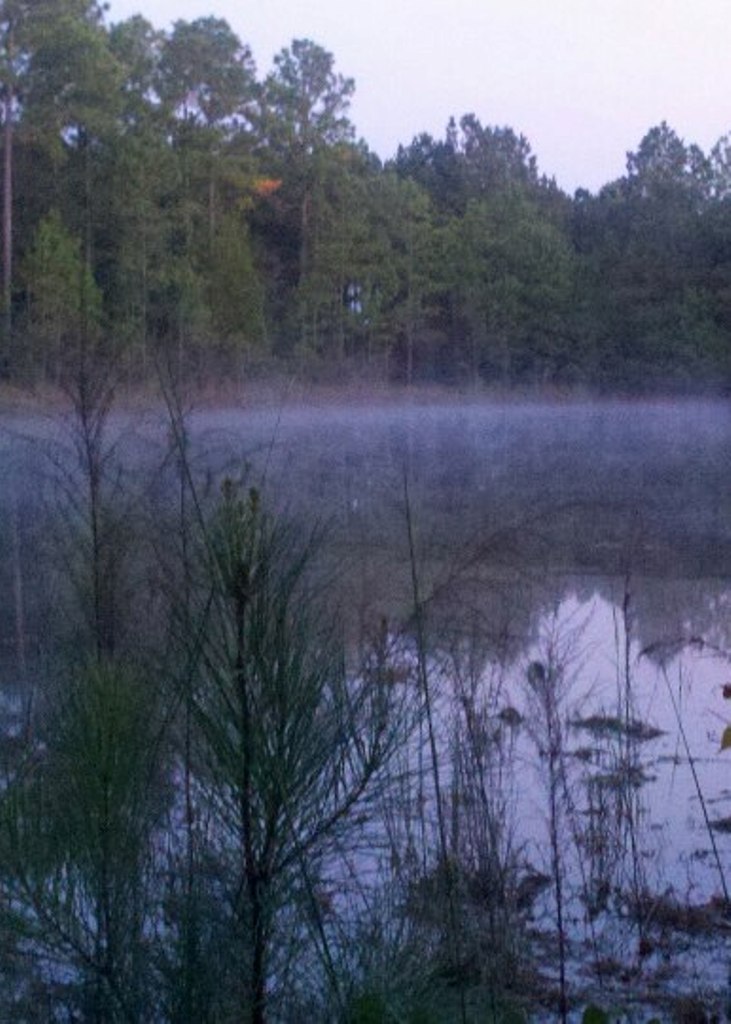
by Jennifer Bearden | May 1, 2015

Photo by Jennifer Bearden
These days many ponds are just backyard recreational ponds. Management goals vary from owner to another. Some pond owners want very little productivity (very little fish removed). They want little vegetation with just a few fish. This pond is just meant for relaxation and aesthetics. Other pond owners want to fish every once in a while but primarily just want to enjoy the wildlife that’s attracted to it. And then others want to manage their ponds for great fishing whether it’s trophy bass, trophy bluegill or just a good balance of the two.
Each goal has very different management practices associated with it. When a pond owner asks about a management practice like fertilization, my first question to them is, “What is your goal for the pond?”
For a pond that is just for aesthetics with maybe a little fishing, I would recommend not fertilizing it. Once pond fertilization has started abruptly stopping this practice can lead to fish kills and re-establishment of rooted plants across the bottom.
When nutrients are added into a pond, they eventually make their way into fish tissue. They can be removed from the pond in the form of removing the fish to keep the pond balanced. Also, fertilization increases the number of microscopic plants, phytoplankton, that are suspended in the water. This gives the pond a green color and can block sunlight to rooted plants along the bottom of the pond. Microscopic plants are the bottom of the food pyramid in the pond. An increase in these plants leads to an increase in the number of fish in the pond.
I would only recommend beginning a fertilization program if a pond is going to receive heavy fishing pressure and the pond owner is willing and able to commit to continuing the fertilization program.
The desirable pond pH for fishing is 6.0-8.0. Some panhandle soils are acidic and have a lower pH value. You can raise the pH by adding lime but always test your water pH before adding lime.
Pond owners should monitor the water clarity using a secchi disk. The secchi depth will tell the pond owner if fertilization is needed or if the pond is in need of aeration. Each year, the fertilization program should begin when water temperatures exceed 65°F and end the program when they fall below 70°F. You can read more at Fertilization of Fresh Water Fish Ponds

by Rick O'Connor | Apr 24, 2015
This rhyme has been around for decades suggesting that rain increases during the month of April. In recent years the amount we have received has caused local flooding, and most in Escambia County will remember receiving 26” of rain in 24 hours! These heavy localized rain events have certainly removed pollen from the air but they have also dropped blossoms from plants, dropped baby birds from their nests, forced fire ants to surface and move to high ground, and then there are the snakes.
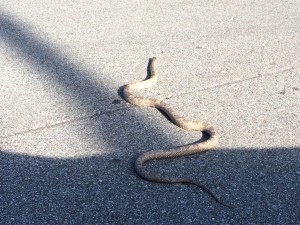
Gray rat snake crossing a driveway.
Photo: Carrie Stevenson
It was actually these flooding events that developed the need for the snake program I am currently doing for Extension. Highly saturated ground forced the snakes to search for high ground. Patios, driveways, garages, and occasionally bathrooms, became popular places for the reptiles to dry off. In the last week or two I have had calls about snakes in buses, on bushes, and in the laundry room, and I actually met someone at a restaurant to identify what kind of snake they found in their home.
For many, it does not matter what kind of snake it is, they are all terrifying and dangerous and unwanted in the yard. For others, nonvenomous snakes are not welcome but they are not life threatening. Venomous snakes on the other hand… well that’s a different story. The problem here is that many do not know how to tell a moccasin from one of the water snakes. When you are not sure, you are more nervous than you may need to be. Venomous snakes truly bother people psychologically.
There are six venomous snakes in Florida and all six have been found in the panhandle. Five of these are members of the “pit viper” group and can be identified by their triangular shaped head, elliptical pupil in the eye, and a heat sensitive pit in front of their nostril. Most venomous snakes also have a dark colored “mask” (stripe) across their face. It is the mask character that I look for first, because many nonvenomous snakes flare their head when threatened and you have to get close to check the shape of their pupil. The pit vipers include the Copperhead, Moccasin, Pygmy Rattlesnake, Timber Rattlesnake, and the Eastern Diamondback. The non-pit viper is the Eastern Coral Snake. Each of these snakes should be considered dangerous and handled only by a professional if in your home. Remember, 95% of the people bitten by venomous snakes are either trying to catch or kill them.
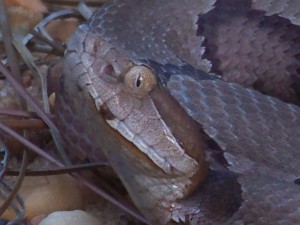
The head of a pit viper. Notice the additional pit, elliptical pupil, and “mask” across the eye. Photo: Molly O’Connor
There are several methods you can use to reduce the chance of an encounter in your yard or home, and Extension would be glad to help with these. But remember, you live in Florida and snakes are part of the landscape here. Also remember there are four snakes in the panhandle that FWC staff are tracking: the Florida Pine Snake, Southern Hognose, Eastern Indigo, and the Eastern Diamondback. If you do encounter any of these visit http://myfwc.com/conservation/you-conserve/wildlife/snakes/ to log a report and include a photograph and GPS location if possible. If you have any questions about snake encounters contact your county Extension office.
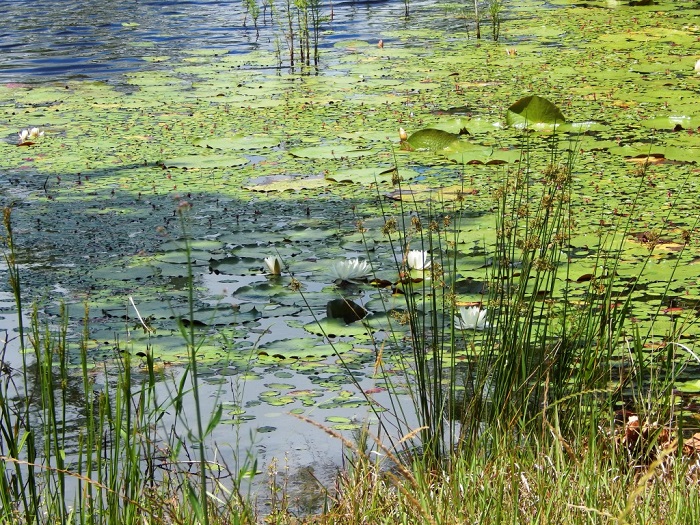
by Mark Mauldin | Apr 17, 2015

Monitor your ponds closely throughout the spring and make any necessary herbicide applications before weed growth becomes too excessive.
Photo Credit: Mark Mauldin
Similar to Goldilocks’ porridge, water temperature doesn’t need to be too hot or too cold, it needs to be just right for using aquatic herbicides (70o – 80o F). Here in Florida, these optimum water temperatures occur in the spring. Water temperature largely regulates the growth of most aquatic weeds; cool temperatures slow or stop growth and warm temperatures promote growth. Keeping this simple principle in mind can help determine when to use aquatic herbicides.
Generally speaking, aquatic herbicides are not used when water temperatures are below 60o F. When water temperatures are this cool most aquatic weeds are not actively growing. For herbicides to be effective the target plants must be actively growing. Applying herbicides too early in the spring is generally not an issue because winter dieback can make many aquatic weeds hard to find when water temperatures are cool. The weeds are out of sight and out of mind. The much more common issue is waiting too long before attempting to control weeds.
As water temperatures climb above 60o weeds begin to grow. Unfortunately, they often times grow unnoticed throughout the spring until they become completely out of control in the summer. By this point, control, even using herbicides, is a monumental task. If at all possible, control weeds early in the growing season.
As plants grow they are able to build up energy reserves, making them more difficult to control. The longer they are allowed to grow the stronger and more difficult to control they become. Controlling weeds earlier in the growing season eliminates this problem.
Similarly, as the growing season progresses plants produce more and more biomass. If an herbicide is applied and the weeds are killed large amounts of decomposing plant material in the water can cause problems. The decomposition process uses oxygen; dissolved oxygen can drop to levels that are hazardous to fish and other aquatic species. The more plant material that is present when herbicides are applied the bigger concern this becomes. Applying herbicides earlier in the growing season, before large amounts of biomass are produced, can help lessen this problem.
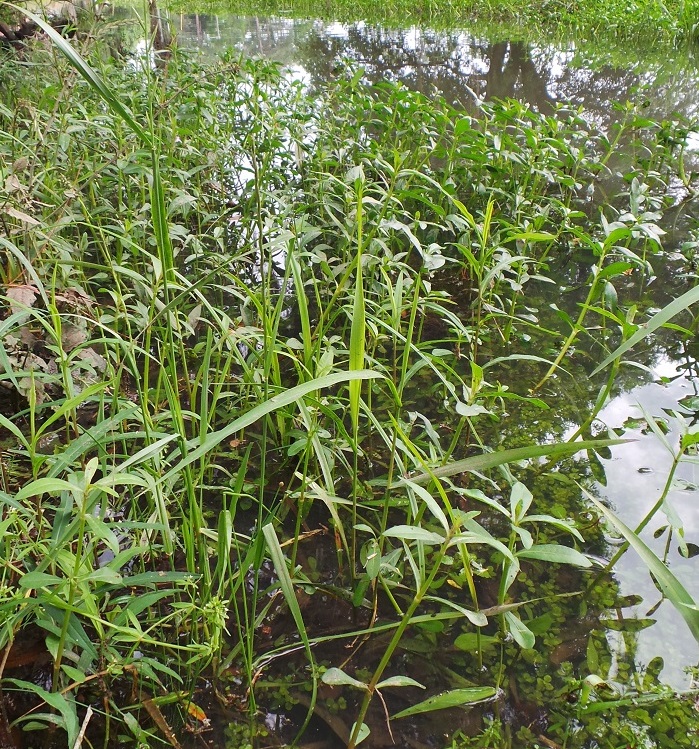
Aquatic weeds can grow rapidly when temperatures are warm. Don’t let them get out of control before you begin control efforts.
Photo Credit: Mark Mauldin
Further compounding the issue, warm water is physically able to hold less dissolved oxygen than cooler water. Late in the summer pond water can be very warm with low concentrations of dissolved oxygen even before large amounts of decomposing plant material are added.
To help reduce the risk of oxygen depletion never treat more than ½ of a pond at one time, if weed growth is already substantial treat no more than 1/3 of a pond at one time and always allow 10 -14 days for oxygen recovery between treatments. Also, avoid treating on cloudy days, another factor that can lead to lowered dissolved oxygen.
Aquatic weed control will be easier and more effective if you monitor your pond throughout the spring and make any needed herbicide applications early, before the weeds have grown too large and the water is too warm. Consult your county extension agent for assistance determining what aquatic weeds you have and if treatment is necessary. Always read and follow all label directions when using any herbicide.













